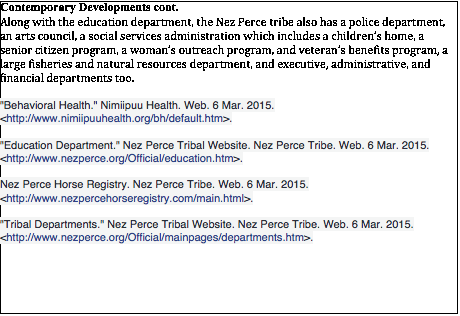Nez Perce
www.nezperce.org
Part 1; History Much like many of the plains tribes, the Nez Perce tribe of the pacific Northwest lived off the land and did so in a successful manner. With the changing of the seasons, the tribes moved over an area of roughly 30,000 square miles in current day Idaho, Washington and Oregon. In Spring, the women of the tribes harvested root crops like bitterroot and wild carrots, while the men went in search for salmon in the Snake and Clearwater rivers. Hunting was done when needed and commonly traveled to find elk and deer on lower land. When horses were introduced to the Nez Perce, they became a staple in the hunting of bison. This led to the tribe being a powerful force on horseback. When the tribes weren't gathering nutritional needs, they were tended other aspects of their living situation. Many families lived under one roof, in a long house was used primarily in the winter or for special ceremonies. The sized varied, but it could be up to 100 feet long. It was covered with tule matts. Running down the middle of the structure was a row of hearths used as a heat source for the families. Each immediate family had their own area within the long house, but shared resources with others living in the structure. Eventually the tipi was introduced and the long house became less common. Tipis were considerably smaller and were much more mobile. The traditional clothing of Nez Perce tribes reflected their resources as well as events and ceremonies. Men could be found wearing on a day-to-day basis shirts, pants, belts and moccasins, all made of buckskin and ornamented with fringe, animal teeth and shells. Similar garb could be seen on the women: they wore long buckskin dresses with moccasins adorned with similar decoration as the men's. As trade and technology advanced, the decoration became more intense and glass and dyes were used. To cope with the frigid temperatures of the winter, bison skin robes were worn. During special occasions, a large feathered bonnet was a common sight for men along with intensely beaded dresses and face paint worn by both sexes. These traditional garments are still worn today for special events. With the tribes being located in the Pacific Northwest, having contact with Lewis and Clark was inevitable. It was recorded in their journals how peaceful the tribes were as well as how helpful they were in their exploration. Even with their peaceful disposition, they were also known for their war strategies. Much about their government was found through these journals. Before the introduction of the “white man” the tribes governed themselves. Each village had a headman that led its people. A council worked with the headman in making important decisions for the people. These positions were usually inherited, but were severely affected when Euro-American colonization moved into their territory. All information generated from Nez Perce Official Website: |
Part 2; Colonial Experience |
Contemporary Developments |
